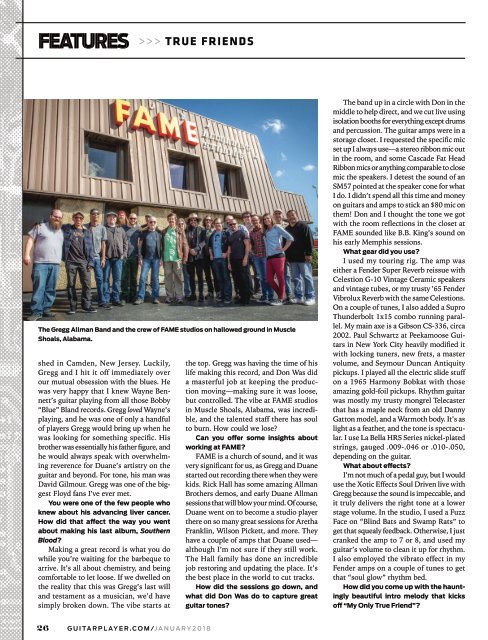You also want an ePaper? Increase the reach of your titles
YUMPU automatically turns print PDFs into web optimized ePapers that Google loves.
FEATURES<br />
>>> TRUE FRIENDS<br />
The Gregg Allman Band and the crew of FAME studios on hallowed ground in Muscle<br />
Shoals, Alabama.<br />
shed in Camden, New Jersey. Luckily,<br />
Gregg and I hit it off immediately over<br />
our mutual obsession with the blues. He<br />
was very happy that I knew Wayne Bennett’s<br />
guitar playing from all those Bobby<br />
“Blue” Bland records. Gregg loved Wayne’s<br />
playing, and he was one of only a handful<br />
of players Gregg would bring up when he<br />
was looking for something specific. His<br />
brother was essentially his father figure, and<br />
he would always speak with overwhelming<br />
reverence for Duane’s artistry on the<br />
guitar and beyond. For tone, his man was<br />
David Gilmour. Gregg was one of the biggest<br />
Floyd fans I’ve ever met.<br />
You were one of the few people who<br />
knew about his advancing liver cancer.<br />
How did that affect the way you went<br />
about making his last album, Southern<br />
Blood?<br />
Making a great record is what you do<br />
while you’re waiting for the barbeque to<br />
arrive. It’s all about chemistry, and being<br />
comfortable to let loose. If we dwelled on<br />
the reality that this was Gregg’s last will<br />
and testament as a musician, we’d have<br />
simply broken down. The vibe starts at<br />
the top. Gregg was having the time of his<br />
life making this record, and Don Was did<br />
a masterful job at keeping the production<br />
moving—making sure it was loose,<br />
but controlled. The vibe at FAME studios<br />
in Muscle Shoals, Alabama, was incredible,<br />
and the talented staff there has soul<br />
to burn. How could we lose?<br />
Can you offer some insights about<br />
working at FAME?<br />
FAME is a church of sound, and it was<br />
very significant for us, as Gregg and Duane<br />
started out recording there when they were<br />
kids. Rick Hall has some amazing Allman<br />
Brothers demos, and early Duane Allman<br />
sessions that will blow your mind. Of course,<br />
Duane went on to become a studio player<br />
there on so many great sessions for Aretha<br />
Franklin, Wilson Pickett, and more. They<br />
have a couple of amps that Duane used—<br />
although I’m not sure if they still work.<br />
The Hall family has done an incredible<br />
job restoring and updating the place. It’s<br />
the best place in the world to cut tracks.<br />
How did the sessions go down, and<br />
what did Don Was do to capture great<br />
guitar tones?<br />
The band up in a circle with Don in the<br />
middle to help direct, and we cut live using<br />
isolation booths for everything except drums<br />
and percussion. The guitar amps were in a<br />
storage closet. I requested the specific mic<br />
set up I always use—a stereo ribbon mic out<br />
in the room, and some Cascade Fat Head<br />
Ribbon mics or anything comparable to close<br />
mic the speakers. I detest the sound of an<br />
SM57 pointed at the speaker cone for what<br />
I do. I didn’t spend all this time and money<br />
on guitars and amps to stick an $80 mic on<br />
them! Don and I thought the tone we got<br />
with the room reflections in the closet at<br />
FAME sounded like B.B. King’s sound on<br />
his early Memphis sessions.<br />
What gear did you use?<br />
I used my touring rig. The amp was<br />
either a Fender Super Reverb reissue with<br />
Celestion G-10 Vintage Ceramic speakers<br />
and vintage tubes, or my trusty ’65 Fender<br />
Vibrolux Reverb with the same Celestions.<br />
On a couple of tunes, I also added a Supro<br />
Thunderbolt 1x15 combo running parallel.<br />
My main axe is a Gibson CS-336, circa<br />
2002. Paul Schwartz at Peekamoose <strong>Guitar</strong>s<br />
in New York City heavily modified it<br />
with locking tuners, new frets, a master<br />
volume, and Seymour Duncan Antiquity<br />
pickups. I played all the electric slide stuff<br />
on a 1965 Harmony Bobkat with those<br />
amazing gold-foil pickups. Rhythm guitar<br />
was mostly my trusty mongrel Telecaster<br />
that has a maple neck from an old Danny<br />
Gatton model, and a Warmoth body. It’s as<br />
light as a feather, and the tone is spectacular.<br />
I use La Bella HRS Series nickel-plated<br />
strings, gauged .009-.046 or .010-.050,<br />
depending on the guitar.<br />
What about effects?<br />
I’m not much of a pedal guy, but I would<br />
use the Xotic Effects Soul Driven live with<br />
Gregg because the sound is impeccable, and<br />
it truly delivers the right tone at a lower<br />
stage volume. In the studio, I used a Fuzz<br />
Face on “Blind Bats and Swamp Rats” to<br />
get that squealy feedback. Otherwise, I just<br />
cranked the amp to 7 or 8, and used my<br />
guitar’s volume to clean it up for rhythm.<br />
I also employed the vibrato effect in my<br />
Fender amps on a couple of tunes to get<br />
that “soul glow” rhythm bed.<br />
How did you come up with the hauntingly<br />
beautiful intro melody that kicks<br />
off “My Only True Friend”?<br />
26 GUITARPLAYER.COM/JANUARY<strong>2018</strong>


